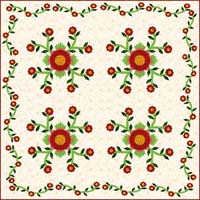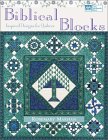Rose of Sharon Quilt Applique Patterns

The Song of Solomon 2
It appears that the Rose of Sharon in the Bible might actually refer to a wild tulip that even today grows on the plains of Sharon in Palestine. When the Bible was translated into English the word "rose" was used.
Of course our foremothers would have imagined a rose, probably a wild rose. When we see this motif on a quilt it is usually a stylized rose like flower. This applique pattern reached it's peak of popularity during the middle of the 19th century and was often done in red, yellow and green. It was usually made for a wedding with it's symbolism of love and marriage.

Rose of Sharon quilts were especially popular in the mid 19th century and made a comeback during the 1920s and 30s.
Although they were made for many reasons the most traditional purpose was for newlyweds. To many ninteenth century quilters this pattern represented romantic love and the sacrament of marriage.
Whatever the purpose these lovely appliqued quilts were usually considered a best quilt to be used only for special occasions or on a bed that would get little wear.
There are a great many variations in Rose of Sharon quilt patterns. Usually stems with leaves and flowers radiate from a central rose. There are also different ways the flowers can be arranged. One way was to make very large blocks, big enough that four of them were enough for the whole quilt. Often the borders consisted of vines with flowers . The picture to the left is an example of this style. Sometimes the this pattern is appliqued on whole cloth making more elaborate arrangements possible.
The Whig Rose is another name for this pattern. It is thought this name came from the 1828 United States Presidential election. The newly formed Whig party hoped to beat out Democrat, Andrew Jackson. The Whig party dissolved in the mid 19th century but the pattern name lived on.
Although Rose of Sharon quilts are more likely to have curved stems the real difference in the names is a matter of what the maker named it. It is also sometimes called the Democrat Rose, Wild Prairie Rose, Colonial Rose, Kentucky Rose or Mexican Rose. I'm sure it's had many other names as well. This is a good example of how varied the names can be for one pattern as well as varied pattern designs for one name.
 I've designed the simple rose, pictured to the right, that can be easily appliqued by hand or machine. It is an optional block that can be used in spacer blocks. For example you might want to alternate pieced blocks with your Rose of Sharon block. If you would like to use a more detailed pattern I've also designed a rose with 4 buds. See an example of it pictured to the left near the top of this page. I've made both examples in a very simplified version. Often the stems or vines would be curved which is something you could do by simply making curved stems for the more advanced block.
I've designed the simple rose, pictured to the right, that can be easily appliqued by hand or machine. It is an optional block that can be used in spacer blocks. For example you might want to alternate pieced blocks with your Rose of Sharon block. If you would like to use a more detailed pattern I've also designed a rose with 4 buds. See an example of it pictured to the left near the top of this page. I've made both examples in a very simplified version. Often the stems or vines would be curved which is something you could do by simply making curved stems for the more advanced block.
The PDFs for these two appliqued blocks do not include seam allowance. If you are fusing the flower you will not need a seam allowance. If you are turning under the edge to applique just add a small allowance. It will curve better if it's narrower than 1/4 inch.
Ignore the letters on the key blocks on the PDFs as the software included a template for every piece in the pattern. I've just left one of each shape. It seems less confusing that way.
| Here are the PDFs for each block. Single Rose Templates Rose With Buds Templates |
There are so many methods used to applique. You could use fusing, applique by machine or use the traditional method of turning the edges to the back and then hand appliqueing.
If you go to the Quilt Index and search the words, "Rose of Sharon" you will find over thirty quilts, most from the nineteenth century. A click on any of them will give details and a click on the picture on that page you will bring up a nice enlargement of the quilt. Most could easily be reproduced using the cut paper method we used when we made snowflakes as children. In fact this might well be how our foremothers designed them.
� 2007 Judy Anne Breneman and Charlotte Bull
print a printer friendly version of this page
With Sacred Threads: Quilting and the Spiritual Life

Biblical Blocks

More Biblical Blocks

Fabric of Faith: A Guide to the Prayer Quilt Ministry

Women of the Bible: 52 Bible Studies for Individuals and Groups

A Quilt of Life: A Patchwork of Devotional Thoughts

Applique Nativity Projects

Symbols of Faith

The Quilt of Life